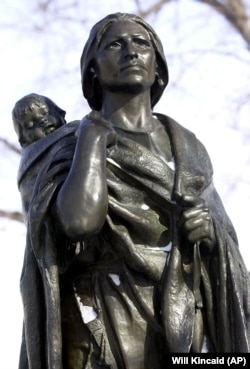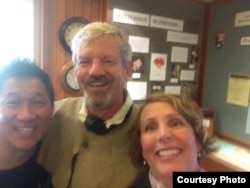ANNA: Hello and welcome to As It Is from VOA Learning English.
ANNA: I’m Anna Matteo in Washington, DC. And today we bring you a live Q&A for our listeners. For those who may have not heard that expression before, Q&A stands for “Questions” and “Answers.” I will be asking the questions, and my co-worker here at VOA, Kelly Jean Kelly, will be answering them.
Kelly has just returned from an exciting road trip, an expedition. And she’s going to tell us all about it. So, welcome to the studio, Kelly!
ANNA: Hi, Kelly. How are you?
KELLY: Great!
ANNA: And let’s just begin with our first question. What is an "expedition.” It’s a great word. Meriam-Webster dictionary defines it as a journey especially by a group of people for a specific purpose, such as to explore a distant place or to do research. But also the group of people who travel together are called an expedition. What was the purpose, Kelly, of your recent expedition?
KELLY: Well, we were actually reporting on another expedition! That expedition happened in 1805. It was led by two men. Their names are Lewis and Clark -- so, Americans sometimes call it the Lewis and Clark expedition.
KELLY: And Lewis and Clark were exploring the western United States. They traveled by boat and over land from St. Louis, Missouri. And you can picture a map of the United States … St. Louis is in the middle in today’s Midwest. And Lewis and Clark traveled from St. Louis all the way to the Pacific Ocean in what is now Oregon. So for our expedition we just traveled over the last part of their journey. We went to Montana and then on to the ocean in Oregon.
ANNA: For one thing that sounds fantastic, by the way. Tell us some of things you learned on this trip -- this expedition -- that made an impression on you. And that means, um, the things you remember because they were so different or so important.
KELLY: So, one of the things I learned was about the other people who traveled with Lewis and Clark. Lewis and Clark are pretty famous in U.S. history. But there was a whole group of people with them. And one of them was a young Native American woman. She was very young. She was maybe 15-, 16-, 17-years old. And she helped translate so Lewis and Clark could talk to the Native American tribe called the Shoshone in Montana. And the Shoshone were very important for Lewis and Clark because the Shoshone helped them get across the Rocky Mountains to the Pacific.
KELLY: This young woman is usually called Sacagewea. But one of the things I learned on this trip is that her name was probably actually pronounced, Sah-caw-gah-wee-ah.
ANNA: That’s very different than we learned in school. What was she translating?
KELLY: So, it was interesting. She was translating the Shoshone language for Lewis and Clark. But she didn’t necessarily speak English. And that was the only language that Lewis and Clark spoke. But she spoke her own language. She spoke a different Native American language. And she spoke some French. And her husband was French. So, she probably heard the Shoshone language, translated it into French, her husband translated into English for Lewis and Clark. There might have been maybe one or two other people involved in that chain of communication. So, you can imagine that any basic conversation could take hours!
ANNA: And you think what could have been lost in translation or perhaps misunderstood going through so many different people.
KELLY: Exactly. Exactly.
ANNA: Don’t go away. When we return we will hear more about Kelly’s trip and more about the Lewis and Clark expedition. You are listening to the VOA Learning English program As It Is.
ANNA: Welcome back. I’m Anna Matteo here in our Washington, D.C. studio with VOA reporter Kelly Jean Kelly. Kelly has just returned from a road trip, or more formally, an expedition, from the American West. But before we continue, I have a language question: How is an expedition different from a road trip or business trip?
KELLY: Oh, that’s a good question. Well, a road trip is usually just for fun. And a business trip is usually for a specific purpose related to your job. So you might go on a business trip to attend a meeting or a conference.
KELLY: But an expedition is really more like an adventure. It’s usually longer than a business trip. And it usually is more for the purpose of learning new information. And in fact, we’ve been talking about the Lewis and Clark expedition -- another name for the expedition is the “Corps of Discovery.”
ANNA: The phrase “Corps of Discovery”: Can you talk about the word “corps.” Our listeners might think it is spelled quite differently than they’re hearing.
KELLY: Oh sure, yeah. Corps is spelled C-O-R-P-S, in this case, like the French word for “body.” And it usually means an organized part of a military group. So, it’s a military word. And that actually makes sense for the Corps of Discovery because it was a military expedition. Lewis and Clark were both soldiers. And most of the men who traveled with them were also soldiers. And the U.S. government paid for the trip. So, you can imagine it like a Special Forces operation.
ANNA: They also had this woman, Sacagawea, whose name we now know is pronounced …
KELLY: Sa-CAH-ga-wea.
ANNA: And she was for part of the trip pregnant. Is that correct?
KELLY: Yes! And that was also something I didn’t realize. And that was particularly meaningful to me because I, actually, am also pregnant, if I can share that with our listeners.
ANNA: Please do. How far along are you?
KELLY: Like Sacagawea I’m six months pregnant. And she was six months pregnant when she joined up with Lewis and Clark and the Corps of Discovery. And, in fact, Lewis and Clark actually helped deliver her baby. So for a good part of this trip she actually had an infant. And she carried him on her back over the Rocky Mountains and then along the Columbia River to the Pacific Ocean.
ANNA: That is fascinating. I actually had no idea as well. It’s almost as if the two of you were sharing a parallel experience while you were on your expedition, although, you probably had a more comfortable of a time.
KELLY: Correct. I thought fondly of Sacagawea as I was traveling in our rental car.
ANNA: So, what can look forward to and our listeners, what can they expect?
KELLY: Oh, we’re going to have a lot of great stuff. We’re going to have a video that talks about the Lewis and Clark expedition. And we’re going to have a lot of pictures. We’re going to have a slide show, including a slide show about Sacagawea. And we’re going to have some different articles about other things that were happening in the time. So, you can imagine and really understand why the Lewis and Clark expedition is so important in American history. It’s a great adventure story. And it’s interesting. And it’s a good character study. But it also really fits into a bigger narrative about U.S. history. So, we’d like to give all of that information to you.
ANNA: Well, thank you Kelly for sharing details, and we look forward to the finished product.
KELLY: Thanks, everybody! It was great to be here. Thanks, Anna!










